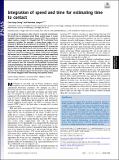Integration of speed and time for estimating time to contact
Author(s)
Chang, Chia-Jung; Jazayeri, Mehrdad
DownloadE2879.full.pdf (1005.Kb)
PUBLISHER_POLICY
Publisher Policy
Article is made available in accordance with the publisher's policy and may be subject to US copyright law. Please refer to the publisher's site for terms of use.
Terms of use
Metadata
Show full item recordAbstract
To coordinate movements with events in a dynamic environment the brain has to anticipate when those events occur. A classic example is the estimation of time to contact (TTC), that is, when an object reaches a target. It is thought that TTC is estimated from kinematic variables. For example, a tennis player might use an estimate of distance (d) and speed (v) to estimate TTC (TTC = d/v). However, the tennis player may instead estimate TTC as twice the time it takes for the ball to move from the serve line to the net line. This latter strategy does not rely on kinematics and instead computes TTC solely from temporal cues. Which of these two strategies do humans use to estimate TTC? Considering that both speed and time estimates are inherently uncertain and the ability of the human brain to combine different sources of information, we hypothesized that humans estimate TTC by integrating speed information with temporal cues. We evaluated this hypothesis systematically using psychophysics and Bayesian modeling. Results indicated that humans rely on both speed information and temporal cues and integrate them to optimize their TTC estimates when both cues are present. These findings suggest that the brain's timing mechanisms are actively engaged when interacting with dynamic stimuli.
Date issued
2018-03Department
Massachusetts Institute of Technology. Department of Brain and Cognitive SciencesJournal
Proceedings of the National Academy of Sciences
Publisher
Proceedings of the National Academy of Sciences
Citation
Chang, Chia-Jung, and Mehrdad Jazayeri. “Integration of Speed and Time for Estimating Time to Contact.” Proceedings of the National Academy of Sciences 115, no. 12 (March 5, 2018): E2879–E2887.
Version: Final published version
ISSN
0027-8424
1091-6490